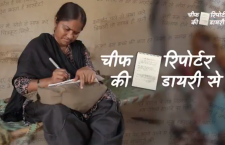Across the districts of Bundelkhand, in some of the most under-developed villages, Khabar Lahariya examines the on-ground impact and efficacy of four of the Modi-led BJP government’s key flagship “pro-poor” policies around housing, health, savings, and fuel.
Pradhan Mantri UjjwalaYojana
“80% of people do not come back for the refilling.” Himanshu Parmar, the owner of HP gas agency in the district of Mahoba in Bundelkhand, Uttar Pradesh, offers the bulls-eye view of the most gaping loophole that sits right at the heart of the Ujjwala Yojna. As daily wages labourer Om Prakash, a resident of Bijapur village in Mahoba says, “My daily wages are 200 rupees. The refilling costs 900 rupees. Do you think I can feed my family this way?”
A flagship programme under the aegis of the Central government, established as a Prime Minister Narendra Modi initiative, the Pradhan Mantri Ujjwala Yojana is a much-feted policy. Undertaken by the Ministry of Petroleum & Natural Gas, the scheme was put into place in 2016 with the express aim of providing clean fuel, i.e. LPG connections, to households that fall under the BPL in the country. What’s more, the connections would be established in the names of the women only – another much-lauded aspect of the policy, and quite radical in nature. The policy’s official website is a daunting showcase of the success of the scheme over two years, its Media Kit link will leave any researcher suitably impressed. Having garnered praise in the WHO pollution report recently, the policy is also the subject of a National Geographic documentary chronicling its impact on the lives of four women across India, the camera tracking closely how their lives have changed phenomenally.
Urmila of Bijapur is clearly not one of them.Having procured the much-coveted object in a May 2017 awareness drive around the Ujjwala Yojna, Urmila recalls fondly the excitement that was generated around it – an LPG cylinder. It lasted her family of five a few months, she shares, though she wasn’t using it regularly. But then one day, the cylinder was empty and that’s when the truth descended on Urmila – the only truth about the policy that matters, the one conveniently left out of awareness drives. “We were told it was free. They were giving it for free, so we got it.”The fact of refilling the cylinder on her own money diluted forever the celebratory mood Urmila’s household had been in. “It’s a huge cost to bear”, Parmar affirms,“Bio fuel is easily available and free. So they go for the usual cow dung, wood etc.”
In February this year, the Union Cabinet approved an allocation of 4,800 crores to the UjjwalaYojana, in an ambitious effort to scale up the connection from 5 to 8 crores by the end of 2019.
Meanwhile, BR Ahirwar, the district supply officer who’s in-charge of ensuring entitlements in Mahoba,lists the factors that entitle you to avail of the free cylinder, “They’re in the woman’s name”, he begins, sure enough, every inch the PR foot soldier we expect, and tells us that the “poor women” should be able to display their registered Antyoday cards, “the red ones”, to be sanctioned a cylinder.
Another list that Ahirwar says he consults for the Ujjwala Yojna is the one with the names of those “entitled for proper homes under the AwasYojana”.
Pradhan Mantri AwasYojana (Gramin)
“Bahut ghotala chal raha hai isme (There’s a lot of corruption going on in this),” says a Faizabad local now working in Delhi, who was shocked to encounter the intensity and extent of the corruption rampant in the name of the housing policy in her town. Indeed, quite literally, in the name of the Prime Minister.
A make-over of the Indira Awaas Yojana (IAY) that was launched in 1996 as a rural housing programme, in an NDA poverty-alleviation bid, the PMAY-G was restructured in 2016 as part of the government’s “housing for all” drive. According to the PMAY-G, all households living in dilapidated and kachcha houses, will be provided a pakka house with basic amenities by 2022.The average cost of a house in rural U.P. is billed at Rs. 1, 20, 000 and the sanctioned amounts are meant to appear in the bank accounts of those entitled, spread across three instalments, of 40,000 each. The policy also incorporates 90 days of unskilled labour work under the MNREGA.
Kalli, a resident of Nivada village in Banda district of Bundelkhand has no idea about either – ghar aur mazdoori. “We haven’t got either from the government,” she says, sitting under a makeshift roof. The sound of a lakh rupees of money, in cash, is an overwhelming one for Kalli.
The paper trail tells a different story.According to overall district numbers, 13, 395 houses have been sanctioned on paper, out of which 12, 062 have been constructed. Kalli’s house is one of the 12, 062.
The Chief District Officer (CDO)Hiralal insists that it’s just a slight lag problem, “There’s going to be a new, revised list that the government has already approved. That survey is pending. Once that is done and we have the new list, we can then go about cross-checking who’s left.”
But when we meet with Prem Narayan Dwivedi, the district level BJP minister, he informs us that it will take the next financial year for all the houses to be completed, since budgets are stuck in this current one.
Pradhan Mantri Jan-Dhan Yojna
The Jan-Dhan Yojana, popularly referred to as the “zero balance account” is shaping up much like the free LPG cylinder of the Ujwala Yojana, when we map efficacy in grassroots Bundelkhand. With a thrust on linking banking facilities and conveniences with the last mile population, the policy aims to embrace the rural populace in a Digital India sweep of an embrace. Nagging concerns of erratic internet connectivity and a lack of overall digital literacy in the majras(hamlets) and villages of rural Uttar Pradesh are, however, the reality.
Farmers queue up for days, at times weeks, Aadhar in tow, for the subsidized material they’re entitled to, and often return to their fields, disappointed, because the machines weren’t working. “Server down” is a peculiar malaise that seems to afflict government offices across Bundelkhand quite often, with district offices and tehsils being most commonly afflicted. “Phalaana nahi chal raha, dhimkaba nahi chal raha”, is how one farmer in Tadi village, Chitrakoot, had put it, in a fit of rage and yet succinctly.
This is the scenario in which Champa of Chitrakoot applied for a Pradhan Mantri Jan-DhanYojana – one of the first people in her village to register herself. “Everyone was running after it then”, she says, almost amused at the thought herself. Champa voices the attitude that speaks for a rural, under-privileged population over the decades – one we encounter too, too often, significant of the extreme lack of awareness around policies in general. “We were told it’s for poor people, so that poor people can also open a bank account. So, I thought I should get it made. I thought maybe the government has finally decided to help us, by giving us money. I thought maybe they would now put it into our accounts directly.”
Ramhit of Tarauha village, Chitrakoot got a Jan Dhan account in his wife’s name in but failed to link it to Aadhaar. He was most interested in the 1 lakh insurance that he was entitled to, he says. At least that is how he understood it. Ramhit, it turns out, was referring to the accidental insurance cover on accidents, which is payable if the account holder has performed a minimum of one successful financial or non-financial customer induced transaction at a bank branch. Ramhit’s unsuccessful adventures with Aadhaar of course rendered that non-functional. When we ask him if he plans to link it now, he’s non-committal, largely unconvinced.
Another peculiar problem that plagues the Jan-Dhan Yojana has to do with the local implementation machinery, which almost always involves bank mitras and lekhpals. These are usually self-styled accountants who manipulate the largely digitally illiterate population of the villages where they live and work, tricking them into monetary transactions that are beneficial only to them. The famous Bundeli middleman who plays the ‘lender’, ‘bank mitra’ role, is seldom interested in this policy though – loan waive-offs and Swachch Bharat-related money movement is more lucrative for him. Ironically, the Jan-Dhan Yojana is officially meant to operate successfully with last mile connectivity in tandem with bank mitras.
Ayushmann Bharat Pradhan Mantri Jan ArogyaYojana
“Nikat bhavishya (near future),” is the timeline that Banda’s Chief Medical Officer, the soft-spoken Santosh Kumar, assigns to an implementation of the Pradhan Mantri Jan Arogya Yojana (PMJAY) in his district.He adds that the policy has been running successfully since August 15 – launched as it was, with fanfare, in the Prime Minister’s Independence Day speech no less – but that the process is a slow one. His own painfully slow tone is perhaps significant of the process itself, “See, the new lists have been downloaded in May & June,” begins Kumar,“There was some error with the old ones. Now these are being fed into the computer one by one. Things have changed since May. Someone’s family has one member less now, the elderly patriarch passed away. So, these revisions take time. Now on the basis of these revisions, health cards will be issued.”
The five lakh insurance cover, “the expense of which will be borne by the Government of India along with insurance companies”, Modi had declared, is currently of little to no use in Banda, where three hospitals that come under the PMJAY bracket – men, women, and children –are all currently seriously short-staffed.
In a district where 78,000 urban families and 1,12, 064 rural families have been identified as the rightful beneficiaries thus far,the Banda District Hospital (Men) has a shortfall of 15 out of 27 medical professionals. At the district hospital for women, things are only marginally better, with the shortage being three out of a total of 15 required doctors. Dr. Usha Singh, Chief Medical Officer (Women), had only non-committal answers about the expected success of the scheme to offer, “Since it is the Prime Minister’s scheme, we will do our best to make it a success,” was all she had to say.
In Mahua village of Banda, 18,091 forms have been filled and submitted – all of them identified as eligible for the PMJAY. Ashish Kumar, the Arogya Mitra, loosely translating as the guy on the local level who’s assigned the DTP kind of work, can’t seem to look up from his phone even for a second, as we ask him questions around this fact. He tells us that he’s been assigned to work for the “card generation process”. Scrolling down his computer screen, he shows us lists upon lists of beneficiaries, “I have just logged into the website. See, now I will put in their mobile numbers.” Ashish’s phone comes in handy for taking pictures too of the beneficiaries and potential beneficiaries who come to start off the process of accessing the world’s most ambitious healthcare yojna. They’ve been told that too.
But when we meet Krishna Kumar, the kotedaar of Mahua village, he is clueless about the PMJAY. He’s never heard of it. “Is this the one for young girls?”, he asks,“Beti Bachaowala?”
And therein hangs a tale.
– Pooja Pande
This Khabar Lahariya article first appeared on Scroll.

